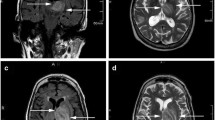Abstract
Infections arising from free-living amebae are rare. They generally cause recognizable disease only in chronically ill, debilitated patients who are immune suppressed. Only about 70 cases of granulomatous amebic encephalitis have been reported. We present an unusual case of granulomatous encephalitis in a 35-year-old man. Neurologic examination and laboratory tests were inconclusive. CT demonstrated bilateral low-density areas with mild mass effect in the cortex and subcortical white matter, which showed increased signal on T2-weighted MRI. Craniotomy and brain biopsy revealed granulomatous encephalitis with acanthamoeba organisms. Though nonspecific, imaging can support the diagnosis of amebic encephalitis and direct biopsy.
Similar content being viewed by others
Author information
Authors and Affiliations
Additional information
Received: 30 April 1996 Accepted: 1 August 1996
Rights and permissions
About this article
Cite this article
Sell, J., Rupp, F. & Orrison Jr., W. Granulomatous amebic encephalitis caused by acanthamoeba. Neuroradiology 39, 434–436 (1997). https://doi.org/10.1007/s002340050440
Issue Date:
DOI: https://doi.org/10.1007/s002340050440




